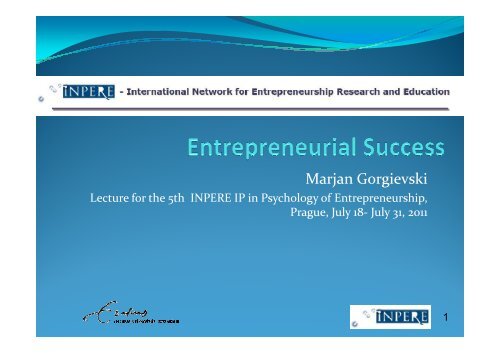IP Entrepreneurial success
IP Entrepreneurial success
IP Entrepreneurial success
You also want an ePaper? Increase the reach of your titles
YUMPU automatically turns print PDFs into web optimized ePapers that Google loves.
Marjan Gorgievski<br />
Lecture for the 5th INPERE <strong>IP</strong> in Psychology of Entrepreneurship,<br />
Prague, July 18- July 31, 2011<br />
1
Assignment<br />
Complete the following sentence:<br />
For me, a <strong>success</strong>ful entrepreneur is / has ….<br />
Give at least three answers<br />
2
Contents<br />
<strong>Entrepreneurial</strong> Success in the Entrepreneurship and<br />
Small Business Literature<br />
Business Owners’ Success Criteria (field study)<br />
Universal Human Values<br />
Success from a Human Values Perspective<br />
Image theatre<br />
3
<strong>Entrepreneurial</strong> <strong>success</strong><br />
Multidimensional approach to entrepreneurial <strong>success</strong><br />
• objective economic <strong>success</strong> criteria (e.g. profit, turnover,<br />
employee growth, innovation, ) (e.g. Schenk, 1998,<br />
Murphy, 1996; Chandler & Hanks, 1993)<br />
• subjective <strong>success</strong> criteria (e.g. satisfaction,<br />
achievement of personal goals and company goals) (e.g.<br />
Schenk, 1998, Kurtko, 1997; Orser, 2005, 2006)<br />
Subjective criteria may be better predictors of subsequent<br />
entrepreneurial decisions and behaviors than objective<br />
economic and business criteria (e.g. Cooper & Artz, 1995)<br />
4
<strong>Entrepreneurial</strong> Success<br />
In the business literature:<br />
1. Profit<br />
<br />
<br />
<br />
<br />
Sales growth<br />
Significant profit margin<br />
Return on capital employed<br />
Return on shareholders’ funds<br />
2. Growth<br />
<br />
<br />
Number of locations expands<br />
Increase in nr. employees<br />
5
<strong>Entrepreneurial</strong> Success (2)<br />
3. Innovation<br />
<br />
<br />
Creates a new market niche<br />
new products are created<br />
4. Continuity and longevity<br />
<br />
<br />
Firm survival<br />
Transfer to the next generation<br />
5. Social and environmental performance<br />
<br />
Green entrepreneurship<br />
6
<strong>Entrepreneurial</strong> Succes (3)<br />
More personal criteria:<br />
6. Allows balance between work and private life<br />
7. Provides personal satisfaction<br />
8. Satisfies clients and employees<br />
9. Socially recognized<br />
10. Provides useful products or services<br />
7
Overview<br />
<strong>Entrepreneurial</strong> Success in the Entrepreneurship and<br />
Small Business Literature<br />
Business Owners’ Success Criteria<br />
Universal Human Values<br />
Success from a Human Values Perspective<br />
Image theatre<br />
8
<strong>Entrepreneurial</strong> Success according to business owners<br />
(Gorgievski, Ascalon and Stephan, 2010; JSBM)<br />
<br />
<br />
<br />
<br />
Provides personal<br />
satisfaction<br />
Is profitable<br />
Satisfies clients and<br />
employees<br />
Allows balance<br />
between work and<br />
private life<br />
9
Ranking of Success Criteria<br />
Provides personal satisfaction 226<br />
Is profitable 133<br />
Satisfies stakeholders 78<br />
Allows work home balance 90<br />
Innovative 64<br />
Useful products or services 47<br />
Continues, long life 43<br />
Gives back to society 30<br />
Expansion 18<br />
Recognition 17<br />
10
Demographics and Ranking of Success Criteria<br />
The younger the business owner,<br />
the more important profitability (Kendall’s<br />
Tau B = -.14, p < .05).<br />
No relationships with gender and education<br />
The larger the business,<br />
the more important continuity (Kendall’s<br />
Tau B = .19, p < .01)<br />
the more important business growth<br />
(Kendall’s Tau B = .20, p < .01),<br />
the less important a good work-life balance<br />
(Kendall’s Tau B = -.15, p < .05).<br />
11
Conceptualization of <strong>Entrepreneurial</strong> Success<br />
(Dej, Gorgievski, Augustin, Wegge, 2009)<br />
company succes<br />
Rentability (e.g. profitable firm)<br />
Growth (employee, revenue, profit)<br />
Innovation<br />
Being better compared with competition<br />
.70<br />
.62<br />
social <strong>success</strong><br />
Contributing back to the society<br />
Social responsibility for employees<br />
Creating new working places<br />
Professional reputation<br />
<strong>Entrepreneurial</strong><br />
.78<br />
<strong>success</strong><br />
Alpha<br />
between .71<br />
and .90<br />
.83<br />
.60<br />
employee &<br />
customer<br />
relations<br />
personal financial<br />
<strong>success</strong><br />
Positive relations with clients<br />
Employee satisfaction and loyalty<br />
Positive & supportive working climate<br />
Personal income enhancement<br />
To afford a good life<br />
Personal financial & family security<br />
personal non<br />
financial <strong>success</strong><br />
Work-life balance & time flexibility<br />
Making decisions, challenge<br />
Personal development<br />
12
Do we now capture it all?<br />
13
Overview<br />
Introduction<br />
<strong>Entrepreneurial</strong> Success in the Entrepreneurship and<br />
Small Business Literature<br />
Business Owners Success Criteria<br />
Universal Human Values<br />
Success from a Human Values Perspective<br />
Image theatre<br />
14
Universal Human Values<br />
Values are concepts or beliefs about desirable endstates<br />
or behaviors that transcend specific<br />
situations, and guide selection or evaluation of<br />
behaviors and events (Schwartz and Bilsky, 1987)<br />
Before we go on, assess yourselves ...<br />
15
10 Values and their relations<br />
16
Universal Values<br />
Achievement Personal <strong>success</strong> through demonstrating<br />
competence according to social standards.<br />
Hedonism<br />
Pleasure and sensuous gratification for oneself<br />
Stimulation Excitement, novelty, and challenge in life.<br />
Self-direction Independent thought and action-choosing,<br />
creating, exploring<br />
Universalism Understanding, appreciation, tolerance and<br />
protection for the welfare of all people and for<br />
nature<br />
17
Universal Values<br />
Power<br />
Security<br />
Social status and prestige, control or dominance over<br />
people and resources<br />
Safety, harmony and stability of society, of relationships,<br />
and of self<br />
Conformity Restraint of actions, inclinations, and impulses likely to<br />
upset or harm others and violate social expectations or<br />
norms<br />
Tradition<br />
Respect, commitment and acceptance of the customs and<br />
ideas that traditional culture or religion provide<br />
Benevolence reservation and enhancement of the welfare of people<br />
with whom one is in frequent personal contact<br />
18
Function of Values<br />
All value orientations serve an important purpose.<br />
The first purpose is to promote and preserve<br />
cooperative and supportive relationships between<br />
people.<br />
Values that serve this purpose include benevolence,<br />
universalism, conformity, security, and tradition.<br />
19
Cooperation and Support<br />
20
Function of Values (2)<br />
The second purpose is to motivate individuals to invest<br />
time and effort in order to perform productively, solve<br />
problems, and generate new ideas and technical<br />
solutions.<br />
Values serving this purpose in particular are selfdirection<br />
and achievement.<br />
21
10 Values and their relations<br />
22
Function of Values (3)<br />
The third purpose is to gratify self-oriented needs.<br />
They include power, hedonism and stimulation.<br />
Some value orientations do not just serve<br />
requirements, but also harm them. For example,<br />
power and achievement may disrupt and damage<br />
social relations.<br />
23
10 Values and their relations<br />
24
Entrepreneurs’ Values<br />
stimulation<br />
selfdirection<br />
universalism<br />
6<br />
5<br />
4<br />
3<br />
2<br />
1<br />
0<br />
benevolence<br />
tradition<br />
hedonism<br />
conformity<br />
achievement<br />
security<br />
Dutch Entrepreneurs<br />
Cross national<br />
power<br />
25
Overview<br />
Introduction<br />
<strong>Entrepreneurial</strong> Success in the Entrepreneurship and<br />
Small Business Literature<br />
Business Owners Success Criteria<br />
Universal Human Values<br />
Success from a Human Values Perspective<br />
Image theatre<br />
26
Values and Success Criteria<br />
Growth profit innovate Satisfact<br />
ion<br />
Balance green recogni<br />
tion<br />
Clients<br />
Security .05 .00 -.13 -.19 .14 -.02 -.06 .07<br />
Conformity -.07 .00 -.20 -.08 .01 -.02 .11 -.02<br />
Tradition -.03 -.11 -.17 .03 .12 .12 .14 -.01<br />
Benevolence -.13 -.10 -.10 .13 .09 .05 -.13 .13<br />
Universalism -.15 -.13 -.01 .04 .02 .16 .08 .03<br />
Self-direction .03 .09 .04 -.01 .04 -.08 -.12 .01<br />
Stimulation .04 .03 .20 .07 -.14 .05 -.06 -.07<br />
Hedonism .01 -.02 .02 .07 .08 -.03 .03 -.07<br />
Achievement .13 .10 .08 -.03 -.10 -.16 .14 .00<br />
Power .18 .25 .10 -.04 -.16 -.16 .01 -.07<br />
27
Values and <strong>success</strong> criteria<br />
1<br />
Openess<br />
Profitability<br />
Continuance<br />
Self enhancing<br />
0,5<br />
Growth<br />
0<br />
Personal satisfaction<br />
Hedonism<br />
Self Direction<br />
Benevolence<br />
Universalism<br />
stimulation<br />
Power<br />
achievement<br />
security<br />
conformity<br />
tradition<br />
Innovation<br />
Recognition<br />
-0,5<br />
Sustainability<br />
Self transcending<br />
Balance<br />
Satisfied stakeholders<br />
Utility<br />
conservation<br />
-1<br />
-1,5 -1 -0,5 0 0,5 1 1,5<br />
28
Conclusions and Discussion<br />
Entrepreneurs define entrepreneurial <strong>success</strong><br />
using “softer” criteria, such as personal<br />
satisfaction, satisfied employees and customers<br />
than most researchers and politicians. Profit is the<br />
only “hard” criterion.<br />
Entrepreneurs score relatively high on selfdirection<br />
and low on conformity, also compared to<br />
cross-national samples of the general population.<br />
29
Conclusions and Discussion<br />
Correlations between values and <strong>success</strong> criteria make<br />
sense. E.g. people who scored high on power ranked<br />
growth and profit higher than people low on power.<br />
Universalists ranked “giving back to society” higher.<br />
30
So Now<br />
You know all about defining <strong>success</strong><br />
You know what your own values profile is<br />
After the break: Image Theatre, building organisations<br />
31
Overview<br />
Introduction<br />
<strong>Entrepreneurial</strong> Success in the Entrepreneurship and<br />
Small Business Literature<br />
Business Owners Success Criteria<br />
Universal Human Values<br />
Success from a Human Values Perspective<br />
Image theatre<br />
32
Image Theater<br />
Technique used in the Theatre of the Oppressed<br />
First elaborated in 1960’s by the Brazilian theatre practitioner Augusto<br />
Boal, initially in Brazil and later in Europe.<br />
Goal: theatre as means of knowledge and transformation of reality in<br />
the social and relational field.<br />
In the Theatre of the Oppressed, the audience becomes active as<br />
"spect-actors" who explore, show, analyze and transform the reality in<br />
which they are living.<br />
The technique was later also used for other purposes.<br />
33
Image Theater Steps<br />
Step 1: Build static images<br />
How many actors?<br />
What is their position?<br />
<br />
<br />
<br />
Distance<br />
direction<br />
Angle towards another<br />
Dynamisation 1: add movement<br />
Dynamisation 2: add speach<br />
“advisors” are invited to improve the image<br />
34







